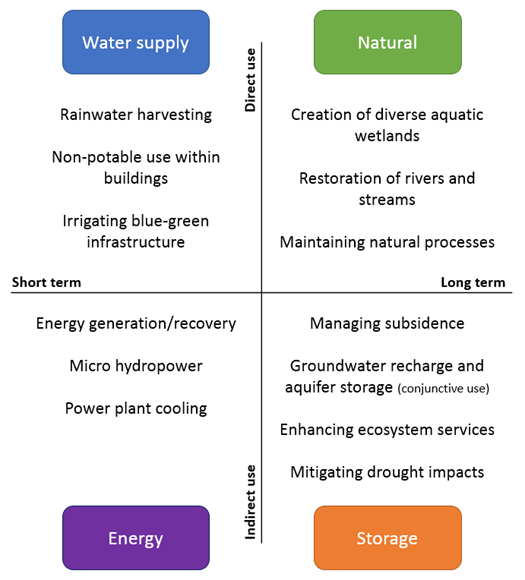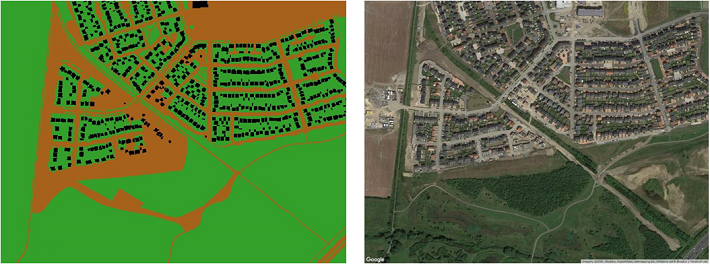WP2. Managing stormwater as a resource
Stormwater is frequently considered a hazard leading to a focus on extreme events at one end of the hydrological spectrum which can cause catastrophic flooding, property damage and potentially loss of life. As we enter a more uncertain climate the need to retain and utilise stormwater as a vital water resource comes more sharply into focus. WP2 examined these options and how they interact with the urban system both in the short and long term, and the benefits that can be secured both directly and indirectly.
We investigated how engineered stormwater management systems can be better aligned with natural processes and other physical infrastructure to:
- realise the resource potential of all forms of urban water, with opportunities for storage, recovery and reuse being taken at every stage of the urban water cycle; and
- provide reliable quantities as required so stormwater management becomes increasingly inter-operable with other urban systems (esp. transport, land-use and energy) (WP3)

Objectives
- Develop procedures and design methods to derive greater benefit from the management of the urban water environment under flood, normal and drought conditions states through utilisation of stormwater resources.
- Examine ways of coupling models for urban hydrology, hydrodynamics, stormwater storage and water quality for the purposes of establishing the potential for both direct and indirect use of stormwater in the short and long term.
- Expand concepts of the ‘stormwater cascade’ where captured stormwater may be utilised multiple times as it moves through urban catchments, including:
-
- Evaluation of the potential benefits of household rainwater harvesting for water supply augmentation and flood management
- Evaluation of the efficacy of the British Standard for rainwater harvesting system design
- Demonstrate the potential benefits of rainwater harvesting in large-scale developments
WP2 Research at University of Cambridge
The potential to recover energy from stormwater was explored by developing a feasibility tool which looks at the key physical/site and climatic characteristics as well as economics. The approach looks at how a retention pond can decouple the problem of intermittent rainfall and energy generation.
The potential for aquifer recharge and storage using stormwater was also evaluated. The work establishes the factors that influence the scheme (climatic, hydro-geologic, water quality, etc.) and the techniques available (e.g. passive infiltration vs. well recharge). An analysis of the current policies hindering the application was carried out and recommendations made.
WP2 Research at University of Exeter
We aimed to systematically evaluate the potential benefits of Rainwater Harvesting (RWH) on water supply augmentation and urban flood management in UK cities, using the methodology illustrated in the diagram (right).
This approach was applied to both household and large-scale RWH systems in the Northwest Cambridge Development, using a 30-year simulation period.
UKCP09 hourly rainfall data sets (30-year time horizon from 2010 to 2039) were also used in the model to account for climate change impact on the rainfall pattern and the system performance.
Finally, we evaluated the impact on system performance of different storage volumes taken from the British standard.
WP2 Research at Newcastle University
To understand the potential of rainwater as a resource at the city scale, it is firstly important to gain knowledge of the fate of rainfall. Of importance is the split between green spaces that provide infiltration capacity and impervious surfaces connected to the sewer network, and the extent to which the network is separate or combined.
- We investigated the contribution of stormwater to the waste water system by a) extracting and classifying land use for a set of 26 highly urban catchments located in 6 urban conurbations, and b) coupling with knowledge of the combined/separated sewer network.
- We also evaluated the impact of the built environment on the seasonal water cycle of highly urbanised catchments. We have produced a procedure that can estimate the fraction of the catchment that acts as either “green” (i.e. providing infiltration capacity), or contributes to the combined sewer network or contributes to the separate sewer network.These tools were used to explore the management of surface runoff.
A major focus is the Newcastle/Ouseburn catchment, in which the Newcastle Great Park development will provide over 3000 new homes by 2030.

WP2 Research at Heriot-Watt University
We studyed the ecosystem functioning and services/benefits provided by SuDS ponds and comparing them with non-SUDS ponds (see WP1).
This work aimed to link the characteristics of suspended particulate matter to their impact on pond ecology.
We gathered information on the biological community of the ponds and adjacent areas, using a number of ecological surveys (e.g. vegetation, fungi, vertebrates, aquatic invertebrates). We also characterised the planktonic community of these ponds, and in particular the presence or absence of cyanobacteria, and the abundance of diatoms (plus nutrients in the pond waters).
WP team